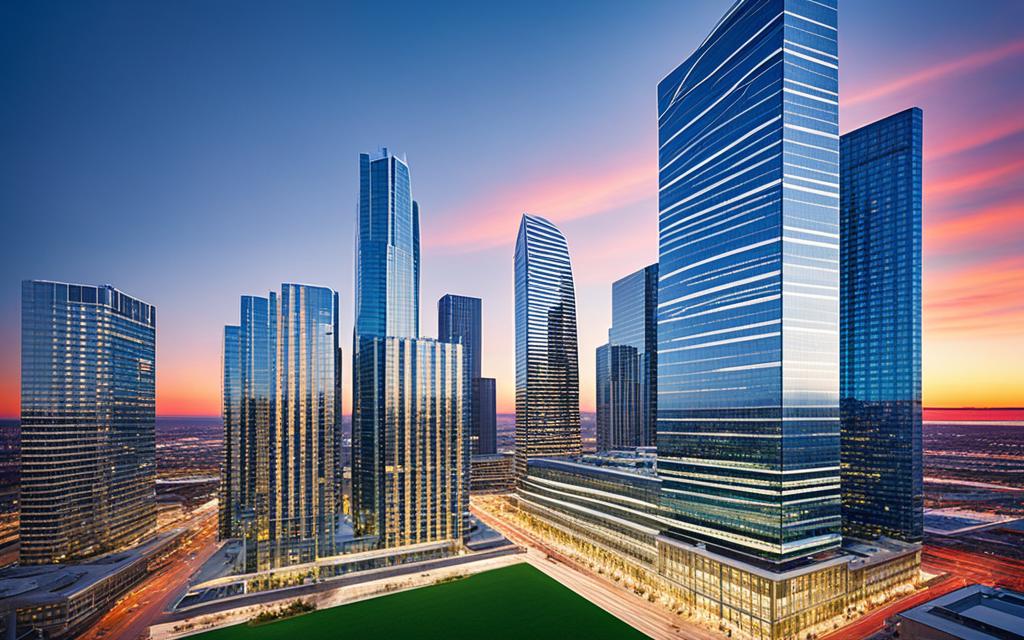
As the world steadily marches into the year 2024, the geist of the commercial real estate market is embracing a myriad of emerging patterns. Particularly in the vibrant Singapore market, where insights have become pivotal for strategic investment in real estate, we find a canvas streaked with both challenges and opportunities. An insightful peek into the commercial property growth trends reveals a landscape steadfast in resilience and adaptability amidst evolving economic conditions.
Distilling key market movements, we unveil how multifamily dwellings and community-centric retail spaces continue to be bastions of strength in a diverse portfolio. Industrial properties, with a nuanced slowdown in certain sectors like cold storage, still command optimistic forecasts rooted in fundamental supply chain transformations. Moreover, the flux of the office sector, with its high vacancy quandaries and shifting paradigms, hints at the latent potential for savvy real estate connoisseurs ready to capitalize on the impending metamorphosis of Class B and C commercial spaces.
Within this intricate web of commercial real estate trends, astute investors and developers in Singapore are positioning themselves to harness strategic investment opportunities, fortified by robust market insight and an unwavering vision for growth.
Current State of the Commercial Real Estate Market
As the calendar turns to 2024, commercial real estate investment strategies must adapt to the evolving global real estate trends that characterize the current market dynamic. Evidence suggests a tempered outlook for capital and space markets, prompting a period of recalibration in various sectors. Operators and investors are now revising their approaches in light of fluctuating interest rates, which continue to play a critical role in shaping market performance.
The late 2023 upheavals, particularly evident in the bond market, underscore the need for real estate professionals to remain vigilant and flexible. A noteworthy trend is the rising cost of construction materials, labor, and insurance premiums, which, while challenging, also offer an opportunity to re-strategize and optimize operational expenses strategically.
In examining sector-specific performance, the multifamily domain emerges with robust endurance. Steady demand indicates a healthy absorption rate, albeit juxtaposed with softening demand for luxury apartments. Meanwhile, the retail sector is positioned to experience growth spurts, especially in areas with high population density, indicating potential for investors with a focus on commercial property.
- Interest rate influence on market recalibration
- Rising operational expenditures as a strategic pivot point
- Resilient multifamily sector and evolving luxury apartment landscape
- Growth potential in retail spaces amidst global real estate trends

In summary, the shifting terrains of 2024’s commercial real estate market call for informed, agile investment strategies that can navigate an array of global trends and pressures. Investors and stakeholders who anticipate and act upon these insights may well find themselves at a competitive advantage in a transforming landscape.
Commercial Real Estate Trends Across Asset Classes
The commercial real estate market is experiencing divergent trends across various asset classes in 2024. These trends reflect a range of demand drivers and economic factors that are unique to each sector. Below is an exploration of key trends impacting office space demand, industrial property trends, and retail market insights, along with the identification of emerging market opportunities.

Office spaces are grappling with shifts in workforce dynamics, leading to a transformative period for this sector. High vacancy rates are driven by a new emphasis on flexible work setups and a demand for higher quality environments. This trend suggests a potential reshaping of office layouts to prioritize collaborative workspaces and tech-enhanced facilities that accommodate hybrid work arrangements.
- Increased adoption of flexible lease terms to accommodate changing business needs.
- Investment in high-quality, tech-ready office spaces as companies seek competitive amenities to attract talent.
- Potential repurposing of underutilized office spaces into residential or mixed-use developments.
In contrast to office spaces, industrial properties, especially warehouses and logistics centers, present robust growth. Market demand in this sector is bolstered by the ongoing trend of reshoring manufacturing operations and optimizing supply chains through nearshoring initiatives. These efforts aim to mitigate risks and ensure a more resilient production framework.
- Steady rent growth anticipated for warehousing and distribution centers.
- Nearshoring of manufacturing driving demand for industrial locations near urban centers.
- Technological integration in industrial properties to enhance operational efficiency.
Retail venues, particularly neighborhood shopping centers, are showing a stable market position with moderate growth in rents and a balance in vacancy rates. Despite e-commerce’s continued expansion, these insights emphasize the enduring role of physical stores in consumers’ shopping habits and community engagement.
- Adaptation of retail spaces to offer experiential shopping and community events.
- Growth of convenience-driven retail formats, such as pop-up stores and last-mile delivery hubs.
- Integration of technology in retail experiences aligning with contemporary consumer expectations.
While the traditional sectors are adapting to new realities, emerging market opportunities also surface, particularly in the realms of sustainable and technologically innovative spaces where tenants and consumers alike seek both functionality and responsibility from commercial venues.
- Increased interest in green-certified buildings as sustainability becomes a paramount concern for businesses and investors.
- Expansion in the niche sectors, such as data centers and life sciences facilities, driven by digital transformation and health sector growth.
- Collaborative spaces that blend retail, work, and leisure, pointing towards a more integrated approach to commercial property development.
Industry Challenges Influencing the Property Market
In the midst of dynamic shifts within the commercial real estate landscape, industry professionals face a series of challenges that are reshaping investment and operational strategies. From monetary policies influencing finance costs to the physical aspects of developing and maintaining properties, these factors directly affect the commercial property market’s stability and growth potential.
Interest Rates’ Ongoing Drama and Impact
With the climate of economic uncertainty, the real estate community remains attuned to the ebb and flow of Federal Reserve rate hikes. As inflationary pressures persist, the conjecture around rate cuts signals a cautious approach for those steering the course of commercial real estate investment strategies.
Construction Costs and Insurance Premiums Rise
Commercial real estate trends have been notably affected by rising construction materials costs and higher insurance premiums. Increases in construction expenses and spiraling insurance costs, propelled by frequent natural disasters, place a significant burden on developers and owners alike, prompting a meticulous commercial property market analysis to adapt to these fiscal changes.
Strategies for Navigating Rising Operational Costs
Efficient operational management becomes paramount as the industry grapples with these unfolding challenges. Implementing robust commercial real estate investment strategies while seeking avenues such as treasury services in real estate can fortify an entity’s financial resilience amidst surging operational costs.
- Enhancement of rent payment systems to streamline cash flow.
- Refinement of payable and receivable processes to maximize operational efficiency.
- Strategic partnerships to optimize treasury management services.
Maintaining agility in financial stewardship not only underpins profitability but also solidifies competitive positioning in the volatile marketplace of commercial real estate.

Commercial Real Estate Opportunities in 2024
As we forge into 2024, the strategies for maintaining a robust commercial real estate portfolio revolve around several critical opportunities. Investors and property managers are placing greater emphasis on liquidity and innovative practices to not only sustain but also grow their real estate assets.
Cash Optimization Tactics for Commercial Real Estate
To secure a competitive edge, the industry is zeroing in on cash optimization in real estate. This includes bolstering commercial real estate liquidity that ensures quick action when desirable properties hit the market at reduced rates. Such tactics involve:
- Smart investment in treasury services
- Utilizing digital payment platforms to facilitate swift transactions
- Strategically capitalizing on market dips to purchase distressed assets
Addressing the Demand for Affordable Housing
With the affordable housing demand continuing to surge, commercial real estate is face-to-face with both a challenge and an opportunity. It’s essential to leverage:
- Innovative housing solutions that reduce construction costs
- Adaptive reuse of existing structures to create new living spaces
- Approaches for tackling NIMBYism and reforming zoning laws to permit a broader range of housing options
Proptech Advancements and Their Benefits
The digital transformation in property management is a game-changer with proptech in commercial real estate paving the way to a smarter, more efficient future. The integration of technology allows us to:
- Enhance building operation via artificial intelligence and IoT devices
- Improve decision-making with real-time data analytics
- Offer tenants advanced digital amenities that add value to their experience
Going Green: Energy-Efficient Building Upgrades
Eco-friendly real estate investments are rapidly gaining traction as they cater to both environmental and financial sustainability. The trend towards energy-efficient commercial properties represents a compelling avenue for asset enhancement, featuring:
- Solar power systems to harness renewable energy sources
- Effective insulation and HVAC systems to reduce energy consumption
- Water-saving fixtures and recycling systems to lower utility bills

The year 2024 heralds an era where commercial real estate professionals must be agile, innovative, and environmentally conscious to succeed. By implementing these strategies, the sector can look forward to thriving in an ever-evolving market landscape.
Office Space and Retail Market: Adaptation and Evolution
The commercial landscape in Singapore is witnessing a distinct shift in office space demand, as the ubiquity of remote work reshapes our professional lives and in turn, impacts the valuation of commercial properties. Quality has become the delineator for valuation in the office sector; superior-quality spaces continue to fetch a premium while lesser properties fall behind, widening the value gap. This dynamic has catalyzed advancements in office design, geared towards hybrid work models that soothe the transition for organizations wading through the permeable boundaries of today’s work environments.
In parallel, the retail segment confronts its evolution with a sense of resurgence. Past consumer wariness seems to have given way to a burgeoning optimism, paralleled by the market’s adaptability. Notably, retail market insights reveal the sector’s ingenuity in integrating digital capabilities, a pivot that has proved crucial amidst the shift toward online commerce. Further fueling this transformation, the retail landscape in Singapore is redefining itself through major retailer consolidations, which have helped to stabilize tenancy demand and emphasize the necessity for merchants to enhance their digital fluency.
The narrative of commercial real estate in Singapore is one of adaptation and progression, with both office spaces and retail outlets finding their footing in a post-pandemic economy that values flexibility, innovation, and resilience. As these sectors embrace structural and strategic changes, the future holds a promise of a diversified, tech-savvy, and agile market landscape ready to meet the evolving demands of businesses and consumers alike.

